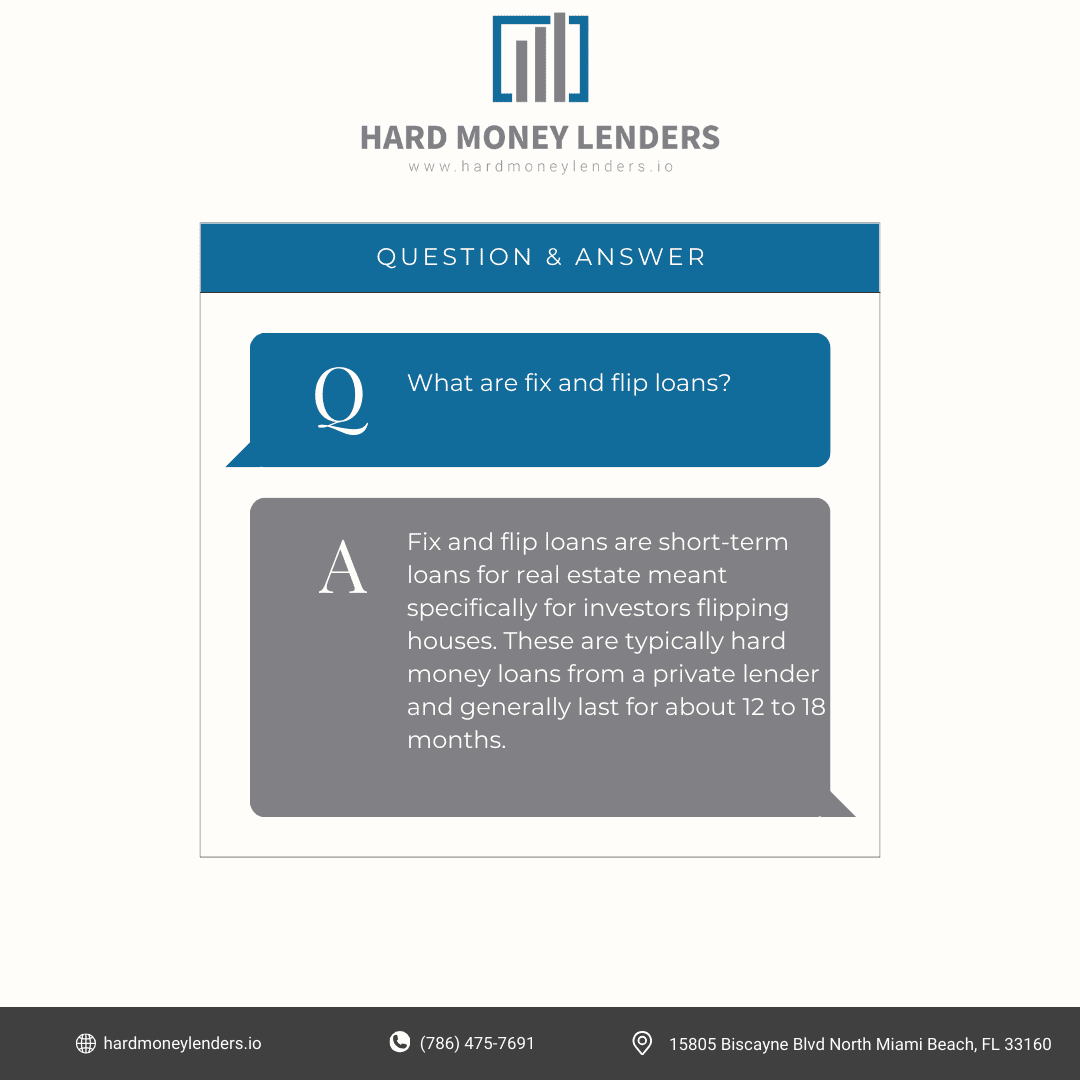Last Updated on May 25, 2024
Are you wondering how to flip a house with no money? Although flipping houses can be very lucrative if done correctly, it can be hard to get started, as you will need sufficient funds to purchase a property to fix and flip. Traditional mortgages and many common methods of financing to buy a house are meant for personal residences rather than real estate investment properties. Fortunately, there are alternate methods of financing for flipping houses, such as fix and flip loans.
In this guide, you’ll learn:
- What fix and flip loans are
- How fix and flip loans differ from traditional home loans
- How construction loans relate to fix and flip loans
- Why hard money lenders offer fix and flip loans
- Advantages of fix and flip loans
- Disadvantages of fix and flip loans
- How to get financing for flipping houses
- How to get a fix and flip loan
What are Fix and Flip Loans?
As implied by the name, fix and flip loans are short-term loans for real estate meant specifically for investors flipping houses. These are typically hard money loans from a private lender and generally last for about 12 to 18 months. Investors can use the money from these loans to purchase a property and finance renovations, so that they can later sell the property for a profit. Fix and flip loans are great for real estate investors looking for a way to get started flipping houses. If you choose a suitable property to fix and flip, you should ideally make enough money to pay back your fix and flip loan and still have a profit left over.
“Fix and flip loans are great for real estate investors looking for a way to get started flipping houses.”
Understanding Fix and Flip Loan Structures
Interest-Only vs. Amortized Payments
Fix and flip loans are designed to cater to the unique needs of real estate investors, particularly those involved in short-term projects like house flipping. These loans are typically structured with either interest-only payments or amortized payments.
- Interest-Only Payments: In an interest-only loan, the borrower is required to pay only the interest part of the loan during the term, which can last from 6 to 18 months. This type of payment structure significantly reduces the monthly outgoings, preserving cash flow. This is particularly advantageous during a flip because it allows investors to allocate more resources towards substantial renovations without worrying about large monthly payments eating into their budget.
- Amortized Payments: Amortized loans, on the other hand, involve payments toward both the interest and the principal balance throughout the loan’s duration. These payments are typically structured to be consistent throughout the term, leading to a gradual decrease in the principal amount owed. Although this type of loan is less common in short-term financing due to its impact on available cash flow, it may be suitable for projects with a longer timeline or for investors who wish to reduce their liability progressively.
Loan-to-Value (LTV) and After-Repair Value (ARV)
When it comes to determining the amount to lend, lenders of fix and flip loans rely heavily on the Loan-to-Value (LTV) ratio and the After-Repair Value (ARV).
- Loan-to-Value (LTV): The LTV ratio is a financial term used by lenders to express the ratio of a loan to the value of an asset purchased. In the context of fix and flip loans, the LTV is based on the current market value of the property. This value determines the maximum amount a lender is willing to finance relative to the property’s current market price, often up to 80-90% for properties deemed a good risk.
- After-Repair Value (ARV): The ARV, on the other hand, is an estimate of the property’s value after all renovations are completed. Lenders look at the potential profitability of the project by assessing what the property will likely be worth after the flip. Typically, lenders provide funding based on a percentage of the ARV, usually around 65-70%. This calculation is crucial as it allows lenders to ensure they do not over-lend, protecting their investment while also enabling the borrower to cover both the purchase price of the property and the cost of renovations with enough room to make a profit on resale.
Both these calculations are integral to the lending decision process and are rigorously evaluated to ensure that the loan remains a secure and profitable venture for both the lender and the borrower. By understanding these metrics, investors can better prepare their proposals and funding requests to meet the specific criteria required by lenders specializing in fix and flip projects.
How are fix and flip loans different from traditional home loans?
Traditional home loans are designed to help a borrower purchase a house that they will live in for many years, and so these loans are designed to be paid off over years or even decades. As a result, these loans use the borrower’s credit as collateral and often last between 15 and 30 years. They also have relatively low interest rates, typically between 2 to 4%, due to the long term of the loan.
Fix and flip loans, on the other hand, are meant for the short-term purchase and renovation of a property that will later be resold. The property itself acts as collateral for the loan, which usually last anywhere from 6 to 18 months. These loans have higher interest rates, generally between 12 and 18%, due to the short duration of the loan. Hard money lenders will typically let you borrow a certain percentage of the home’s ARV (after-repaired value), which will ideally give you enough money to purchase the property and fund some or all of the renovations (for more information, check out our guide on how to get 100% financing through hard money loans).
In a fix and flip loan, the hard money lender has the first lien on the property, which is usually the position held by a bank in a traditional home loan. However, just like a traditional home loan, the borrower owns the property and deed.
Do I need a construction loan as well as a fix-and-flip loan?
Construction loans and fix and flip loans are somewhat similar, as both can involve hard money lenders. However, if you’re doing construction in the process of renovating a house to be resold, you don’t need a construction loan. Construction loans are mainly used for building brand new properties or demolishing entire buildings. You can use the funds from a fix and flip loan for all your renovation and construction needs that come with flipping the house.
“You do not need a construction loan to renovate a house to be resold. The funds from a fix and flip loan can be used for all your renovation and construction needs!”
Why do hard money lenders offer fix and flip loans?
Although fix and flip loans may seem risky for hard money lenders, there are some benefits that can motivate private lenders to offer these loans. For one, real estate is a relatively secure investment, and should you default on the property you purchase, the lender will still have that property to sell as collateral. Additionally, private lenders like that these loans are short-term, as they will hopefully see a return on their investment within only a year or so. These advantages can make a fix and flip loan a worthy investment for a hard money lender, though they will still want to make sure they are offering loans to quality investors. If you’re looking for a fix and flip loan, it’s important to demonstrate your reliability to a private lender.
Why should I get a fix and flip loan?
Hard money fix and flip loans have a lot of advantages for real estate investors. When it comes to financing for flipping houses, fix and flip loans are a great option because they are fast, flexible, and not as risky as some traditional home loans can be. Fix and flip loans are the way to go if you’re looking to flip a house with no money. Hard money fix and flip loans can help you buy property in competitive markets because you can get funding within a few days, as they don’t have to go through the same strict processes and bureaucracy as traditional banks.
You can also get a fix and flip loan even if you don’t have good credit, as your credit score is less important to private lenders than the property in question and your ability to improve upon it. Likewise, while hard money lenders may still want to see some of your financial documents (such as tax returns or bank statements) before offering you a loan, they generally don’t care about debt-to-income ratios or where the funds for a down payment come from. Finally, a hard money loan is backed by the property you purchase with it, so you don’t have to worry about losing your own home if things don’t work out.
 What are the problems with getting a fix and flip loan?
What are the problems with getting a fix and flip loan?
The main drawback of fix and flip loans is that they can get expensive if your flip takes longer than expected. These loans are meant to be short-term and have high interest rates, which can become expensive fast if your fix and flip timeline gets extended too much. Be careful getting a fix and flip loan if you know you’re likely to run into problems during renovations that might slow down your timeline significantly, or if you think your completed flip will take a long time to sell. If you are contracting out the renovations, this is part of why it’s important to find a good contractor to ensure that everything goes according to plan.
How do I get financing for flipping houses?
There are a few different methods of finding financing for flipping houses.
Private hard money fix and flip loans
You can find hard money lenders online, though the amount of money, fees, interest rates, and down payment will vary depending on the lender. You can also contact local real estate agents, investors, and real estate associations for recommendations of hard money lenders in your area. Here at Hard Money Lenders, we have a great fix and flip loan program. Feel free to contact us if you are located in Florida and have any questions or would like to meet for a consultation regarding our fix and flip loans.
Crowdfunding
With crowdfunding, rather than having a single hard money lender or a single individual finance your loan, a group of institutions or individuals each contribute a small amount of money and collectively finance a loan. These work similarly to loans from hard money lenders but often have less flexibility and move slower, as the money must come from multiple places. There are specific crowdfunding websites designed for house flipping financing, such as Groundfloor, Patch of Land, and Fund That Flip. Be careful using crowdfunding sites that aren’t directly intended for purchasing real estate, as they will usually have lower maximum loans than the funding you need for a fix and flip.
Individual lenders
Individual lenders are essentially just people who have spare funds and are willing to loan some of it to promising investors. These lenders typically are more flexible and have better rates compared to hard money lenders. They can be a good option for beginners who don’t have an impressive portfolio to win over a hard money lender. You can network and find individual lenders at your local real estate events. Although individual lenders can be great for beginners, they can be difficult to find, so be prepared to put in some time and effort if you’re hoping to find one.
How do I get a fix and flip loan?
Although hard money lenders don’t care about your credit score the way traditional banks do, that doesn’t mean that it’s always easy to get a hard money loan. It’s important to find a hard money lender who fits your needs and is willing to invest in your project.
One way to find a good fix and flip loan is to ask other local flippers for recommendations of hard money lenders. You ideally want someone who is local, as they will be able to give you advice based on the area, and reliable. Having a supportive, high-quality hard money lender can help make your fix and flip much smoother and more efficient. Again, this is particularly ideal for beginners, as a helpful hard money lender can teach you key information about the industry and market in your area.
“It’s important to find a hard money lender who fits your needs and is willing to invest in your project.”
Once you’ve found a potential hard money lender, figure out the costs of your fix and flip and how much money you’ll need. Our Fix and Flip Loan Calculator is a great resource for this! Create a schedule of your planned renovation; the more detailed, the better. Do your research on the specific lender you’re interested in and find out what their specifications are before you apply for a fix and flip loan. All of these will help show hard money lenders that you are prepared and trustworthy, making them more willing to offer you a fix and flip loan.
Finally, before agreeing to a loan, make sure you discuss all the conditions involved. You should always know exactly what you are agreeing to.
If you’re located in Florida, see this article for more information on fix and flip loans.
Step-by-Step Guide to Applying for a Fix and Flip Loan
Applying for a fix and flip loan is a comprehensive process that requires detailed preparation and a deep understanding of the lender’s requirements. Here’s an in-depth look at each step involved in the application process, complete with the necessary documentation and criteria that can strengthen your loan application.
Application Process
1. Pre-Qualification
- Purpose: The initial step to gauge your eligibility based on basic financial data.
- Process: You need to provide preliminary information such as your overall financial health, credit score, and experience in real estate investments. This stage is typically quick and can often be completed online or through a short phone call with the lender. The goal here is to establish a preliminary understanding of your financial position and investment strategy.
2. Formal Application
- Purpose: To comprehensively apply and provide detailed data for loan consideration.
- Process: This step requires filling out a detailed loan application form where you must include extensive information about your financial background, specific details of the project, and your strategy for the flip. It’s essential to be as detailed as possible, providing timelines, projected costs, and expected outcomes.
3. Property Evaluation
- Purpose: To determine the current market value of the property and its potential value after renovations.
- Process: A licensed appraiser will perform an evaluation to ensure the property’s value is appropriate for the loan amount. The appraisal will assess the current state of the property and project its worth post-improvement, which is crucial for securing the loan.
4. Underwriting
- Purpose: To assess the risk associated with funding the loan.
- Process: The underwriter will review your application in detail, scrutinizing aspects such as credit, income, and the viability of the project plan. They will verify all submitted financial data and evaluate the risks linked to the proposed renovations. This step is vital as it determines the financial solidity of your plan and the likelihood of loan approval.
5. Approval and Loan Closing
- Purpose: To finalize the terms of the loan and release the funds.
- Process: Once approved, you will receive a closing package, including a final breakdown of fees and payments. At this stage, you will need to sign several legal documents that define the loan terms. After all documents are signed and returned, the loan funds are disbursed, allowing you to proceed with the purchase and renovation of the property.
 Comparative Analysis of Financing Options for Fix and Flips
Comparative Analysis of Financing Options for Fix and Flips
When considering financing for fix and flip projects, investors have multiple options, each with distinct advantages and disadvantages. Understanding the differences between these financial tools can help investors choose the most suitable method for their project needs and financial situation. Here’s a breakdown of some common financing options:
1. Fix and Flip Loans (Hard Money Loans)
- Advantages: These loans are fast to secure, often processed within days. They are primarily asset-based, meaning the loan is secured by the property itself rather than the borrower’s creditworthiness. This can be beneficial for investors with less-than-perfect credit.
- Disadvantages: The interest rates are typically higher than traditional loans, reflecting the higher risk and shorter loan term. They also require the property as collateral, which can be risky if the project does not proceed as planned.
2. Home Equity Lines of Credit (HELOCs)
- Advantages: If the investor owns another property, a HELOC allows them to tap into their home equity at relatively low interest rates. It’s flexible, with the borrower drawing and paying interest only on the amount used.
- Disadvantages: It puts the borrower’s primary residence at risk since it is used as collateral. Also, the availability of funds depends heavily on the existing property’s equity, which may not be sufficient for all renovation needs.
3. Private Lenders
- Advantages: Similar to hard money loans, private loans can be flexible and quick to arrange. Terms can be negotiated directly with the lender, often leading to more personalized financing solutions.
- Disadvantages: Interest rates and terms can vary widely; they often depend on the relationship between the lender and the borrower. There’s also a higher risk of unpredictability in terms of agreement enforcement and professional standards.
4. Traditional Bank Loans
- Advantages: These loans come with lower interest rates compared to hard money loans and are typically amortized over a longer period, reducing the monthly payment burden.
- Disadvantages: They require a longer approval process, involve stringent credit checks, and often do not cater to the quick turnaround required in fix and flip scenarios. Additionally, they may not offer the flexibility needed for covering renovation costs.
5. Crowdfunding and Peer-to-Peer Lending
- Advantages: These platforms offer the ability to raise funds quickly from multiple investors, which can be a great option for projects that capture public interest. They often provide competitive interest rates and flexible terms.
- Disadvantages: Requires a compelling pitch and potentially broader exposure of the project to secure funding. Also, the administrative burden and fees can be higher than other options.
Conclusion
If you are just getting started flipping houses and wondering how to flip a house with no money, there are options available for house flipping financing! A hard money fix and flip loan could be the key to your beginning as a real estate investor. Don’t be afraid to consider options such as hard money lenders, private individual lenders, or even crowdfunding websites for funding. If you’re in Florida, feel free to contact Hard Money Lenders for help! All you need to do to apply for a loan is fill out our quick and easy Fix and Flip Loan Interest Short Form.

Jack Roberts has spent the last 5 years in the Private Money Lending world helping real estate investors secure financing for their non-owner occupied real estate investments. When he’s not thinking about real estate, Adam is an avid Jazz music fan and fisherman.






